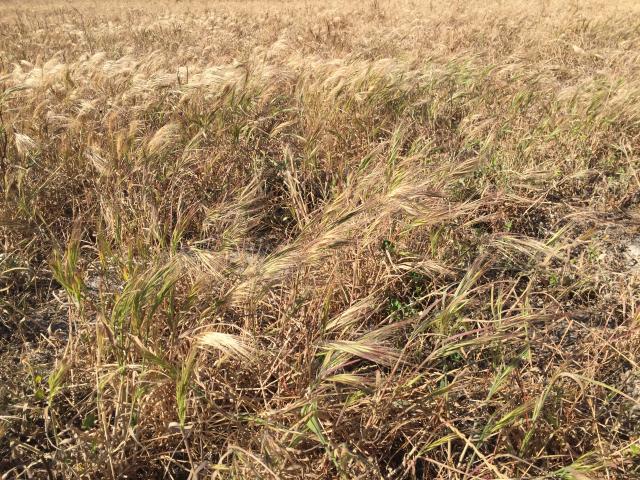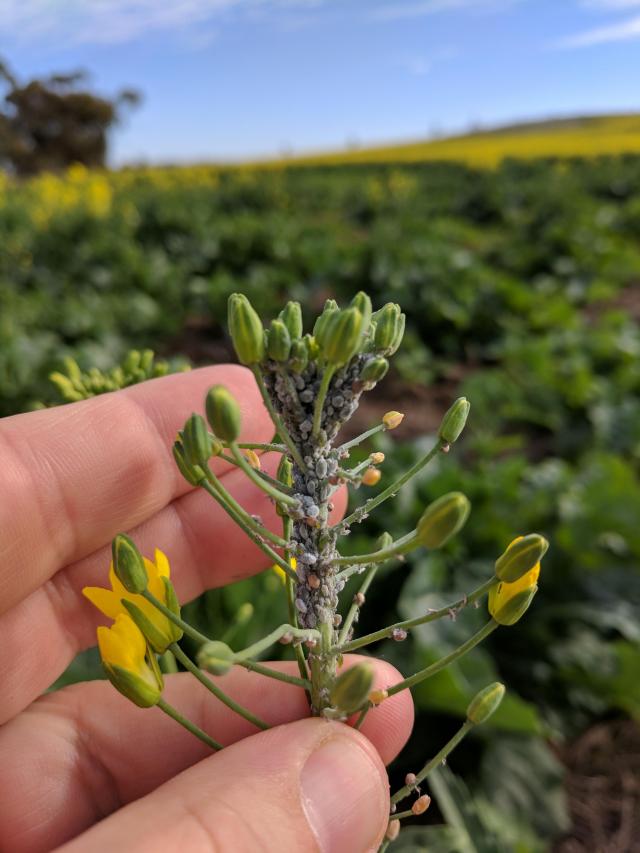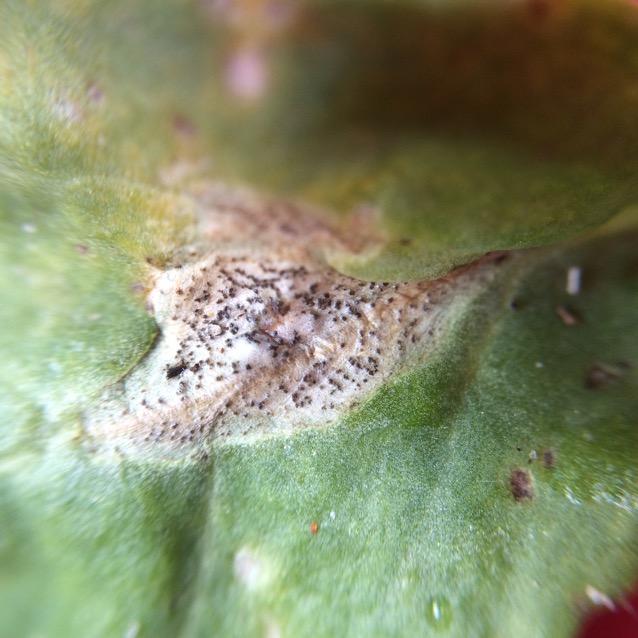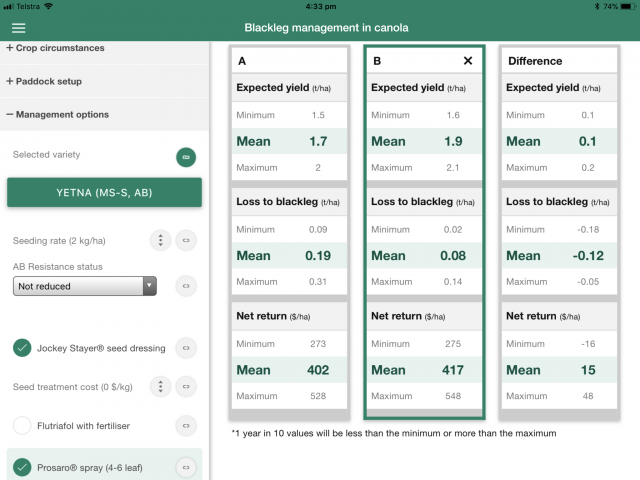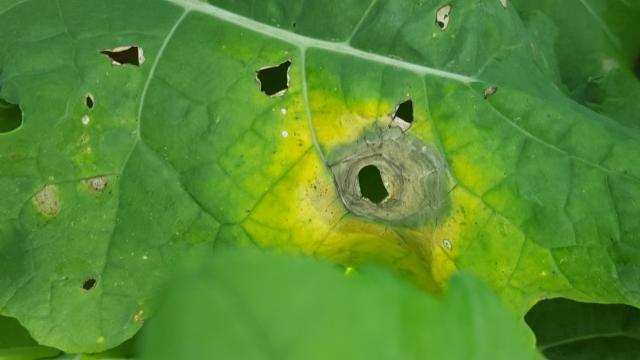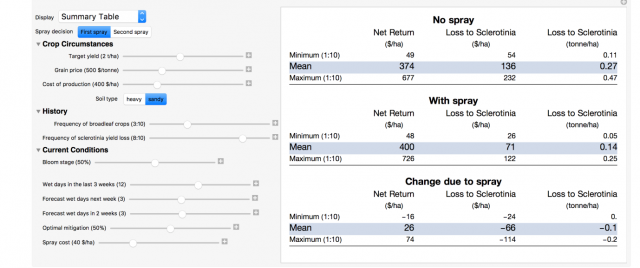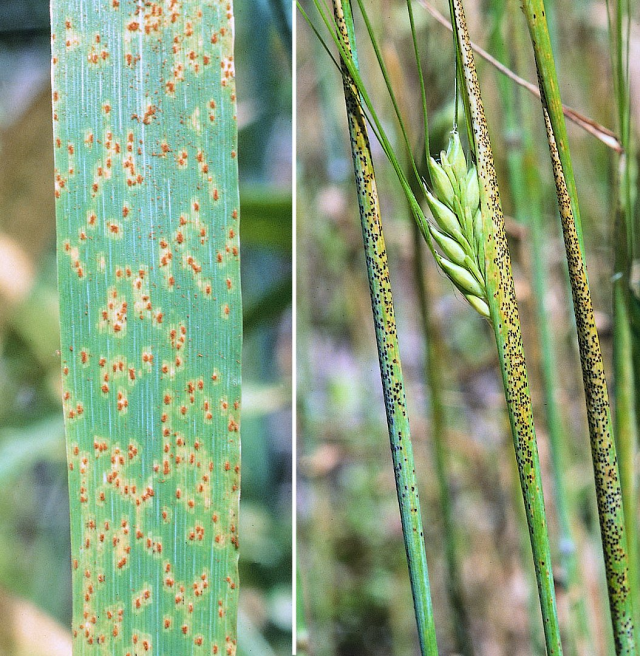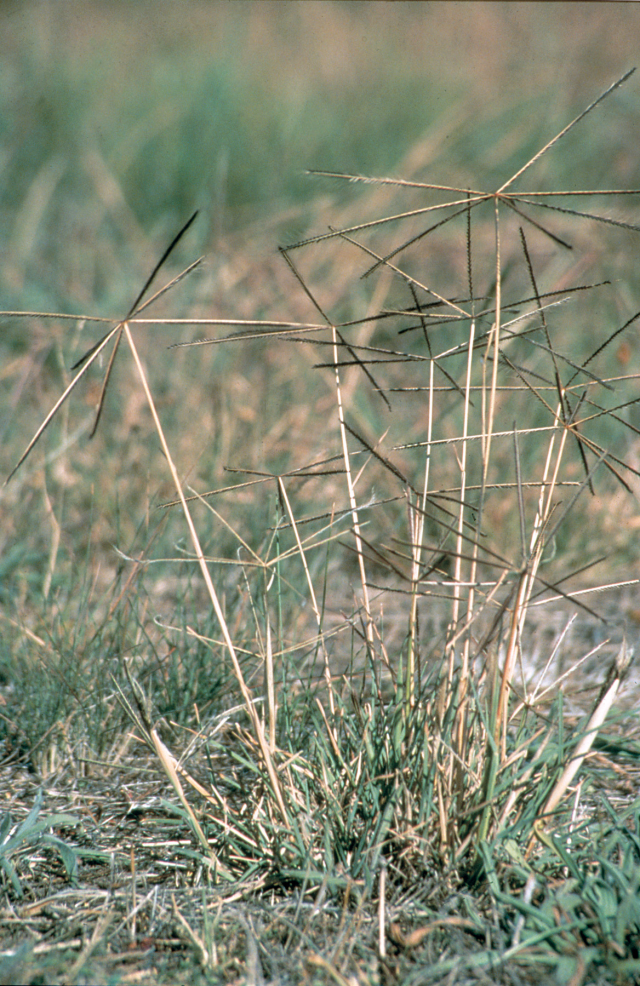Research Updates 2018: the written papers
As always the WA grains industry’s social calendar starts with GRDC’s Perth and regional Research Update events.
A variety of topics are presented directly to the audience but there is also a considerable body of research work that is provided to delegates in the format of written papers. These research papers are also available later on at the GIWA website for free public consumption.
This issue of Protecting WA Crops will highlight the following research papers that are available online;
- Are you considering harvest weed seed destruction in 2018? Here are a few more things to think about
- New app’s for the WA grains industry - Crop Scout, Blackleg CM, Sclerotinia
- Barley leaf rust
- Emerging weeds
- Herbicide tolerance in oats and canola
These research papers cover the topic of crop protection but there are many other topics that have been written about and published so readers are advised to visit the GIWA Research Updates papers webpage and investigate.
Are you considering harvest weed seed destruction in 2018? Here are a few more things to think about
Weed species behave differently at harvest time
Work at Wongan Hills done by Catherine Borger and Abul Hashem, DPIRD Northam, have shown that brome grass and barley grass shed their seed earlier than annual ryegrass. Harvesting, or swathing, as early as possible would be necessary to capture seeds from these species for harvest weed seed destruction.
Weed seed shedding
In 2016 and 2017, the earliest possible harvest date occurred in mid-November (14/11/2016 and 9/11/2017, Table 1). In both years annual ryegrass retained most seed until crop harvest, with only 24% and 13% of seed lost prior to harvest. All annual ryegrass seed heads were above harvest height. In mid-November (14/11/2016 and 15/11/2017), great brome grass had shed 64% of seed in 2016 and 70% of seed in 2017. However, in 2017, the crop was ready for harvest a week earlier (9/11/2017), when great brome grass had only shed 28% of seed. Great brome grass sheds rapidly over November, and in 2016, where harvest did not occur until December, 100% of seed was shed prior to harvest. All great brome grass seed heads formed above harvest height. Harvest needs to occur as early as possible to capture great brome grass seeds.
Barley grass started shedding seed in October, but retained 62% of seed at crop maturity in 2016 (Table 1.) and 96% in 2017 (Table 2). However, in this particular trial, the barley grass was poorly competitive due to late emergence and the plants did not grow taller than 10-12 cm. Therefore, all seed heads were below the harvest height of 15 cm. As the barley grass plants had senesced, crop harvest caused sufficient disturbance to shed the remaining seed heads, but seeds were not captured by the harvester.
| 2016 | Annual ryegrass | Great brome grass | Barley grass |
| 7/10/2016 | 0 | 0 | 0 |
| 24/10/2016 | 1 | 0 | 8 |
| 7/11/2016 | 3 | 1 | 13 |
| 14/11/2016 | 9 | 64 | 38 |
| 25/11/2016 | 24 | 100 | 100 |
| 1/12/2016 | 100 |
| 2017 | Annual ryegrass | Great brome grass | Barley grass |
| 9/10/2017 | 0 | 0 | 0 |
| 24/10/2017 | 1 | 6 | 4 |
| 9/11/2017 | 3 | 28 | 4 |
| 15/11/2017 | 13 | 70 | 8 |
| 23/11/2017 | 100 | 100 | 100 |
Great brome grass germinates at the same time as the crop, it is highly competitive with wheat. It is very important to control great brome grass through an integrated weed management program. Harvest weed seed destruction may be an effective control measure for great brome grass. Earlier studies, by the Australian Herbicide Resistance Initiative (AHRI), have found great brome grass seed retention of 77% at crop and Department of Primary Industries and Regional Development (DPIRD) researchers have found 74% of great brome grass seed could be captured if harvest height was 10 cm. This is similar to the 72% seed retention in 2017 and much higher than the 36% retention in 2016 in the current study.
It is clear that great brome grass seed retention at harvest varies between years, due to seasonal conditions and the time at which the crop reaches maturity. When using harvest weed seed destruction, harvest should be completed as soon as possible in those fields where great brome grass is a problem. Alternatively, swathing may be used to reduce weed seed shedding. Further research is required to determine the success of swathing or harvest weed seed destruction for great brome grass.
Barley grass retained seed more effectively than great brome grass and so harvest weed seed destruction may be effective on populations of barley grass with plants that grow taller than those plants in this trial.
Are sclerotes still viable after grinding?
In a lab experiment, run by DPIRD plant pathologist Ciara Beard, sclerotia that were ground up to simulate the effects of a Seed Destructor (SD) were still able to germinate. Apothecia produced from ground up sclerotia were smaller than those produced from whole sclerotia. Turning the sclerotia into a ‘flour’ (<0.5mm), however, significantly reduced and delayed germination.
Simulating the seed destructing technology by grinding sclerotia
Sclerotia germinated in all treatments despite being ground to different degrees. The finest grind (<0.5mm) was the most effective at reducing the viability of sclerotia (Figure 1). The 1-2mm grind appeared to encourage higher rates of germination and more apothecia. It was noted that the apothecia that formed on all the ground sclerote treatments were smaller in size (estimated at 1-2.5mm) than those that formed on whole sclerotia in another experiment. Apothecia size appeared to be closely related to the size of the fraction with their size decreasing as the sclerotia were ground more finely.
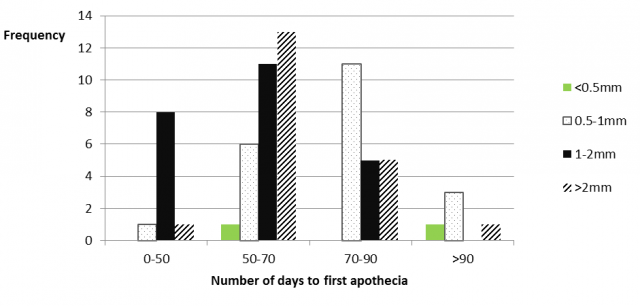
All four sclerote ‘grinds’ germinated, but the finest grind (<0.5mm) showed very low germination to date and germination was significantly delayed. Unless the SD can consistently grind sclerotia to less than 0.5mm this would not be an effective strategy for reducing the viability of sclerotia in a paddock. However use of the SD may reduce productiveness as apothecia on ground up sclerotia were significantly smaller than those produced by whole sclerotia and did not persist for as long and may consequently release fewer spores.
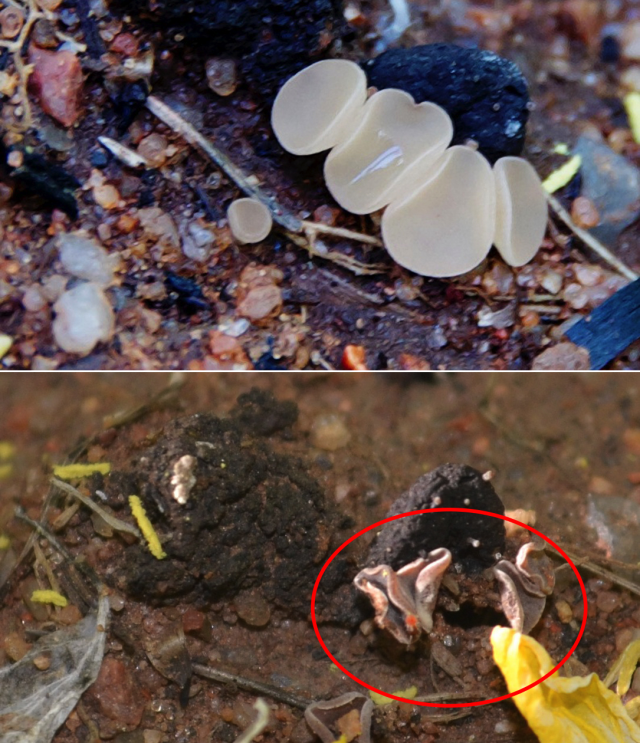
Further research is warranted to determine if smaller apothecia release fewer spores than larger apothecia. It is also acknowledged that grinding up sclerotia may make them more vulnerable to being eaten by mice or ants or broken down by bacteria, which was not investigated in this current work.
Full information on this weed seed research can be found in the following papers available at the GIWA website;
- Understanding how Sclerotinia sclerotiorum initiates stem rot: factors affecting the germination of sclerotia, Ciara Beard and Anne Smith, DPIRD, Geraldton
- What’s the worst weed in Wongan Hills? Catherine Borger, Abul Hashem, Department of Primary Industries and Regional Development, Western Australia
New app’s for the WA grains industry - Crop Scout, Blackleg CM, Sclerotinia
There are a number of apps and decision support tools that are being discussed at this year’s Research Updates.
CropScout
The CropScout app was recently released by DPIRD entomologist Dusty Severtson. It uses the canola aphid sequential sampling plan, which is designed to decrease the number of plant inspections required to assess aphids in canola and assist growers and consultants with making the decision to spray insecticides or not.
Cabbage and turnip aphids are often aggregated along crop edges where they have initially colonised the crop (unless the crop is patchy or has been moisture stressed during colonisation). The user inspects canola plants in a transect starting along crop edges, and the CropScout app automates the calculations in the background and stops when there is 90% confidence that the areas sampled are either
- above threshold (mapped as red),
- below threshold (mapped as green) and
- below but close to threshold (mapped as amber) (Figure 2).
Maps produced on the phone and on the user’s CropScout online personal page are displayed as coloured polylines, enabling a whole-paddock or multi-paddock view of where crops were inspected for aphids and what the spray threshold results were for those locations. The accuracy (error) and threshold may be changed in the settings.
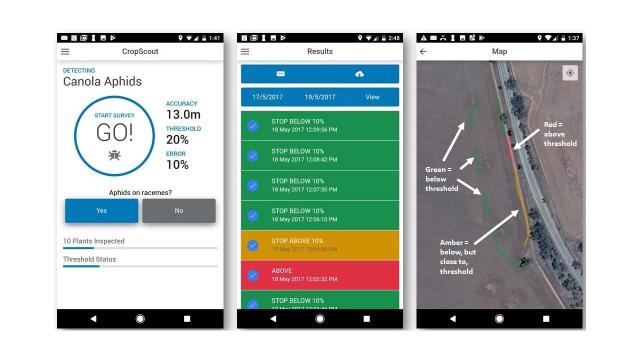
The CropScout app was released on iOS and Android stores on 31 July, 2017 as part of the MyPestGuide suite of apps from DPIRD. The canola aphid is the first module with others being developed including a cereal aphid module. For more information, visit the DPIRD’s CropScout page.
Blackleg Management App - BlacklegCM
The Blackleg management App has been developed by the National pathogen modelling project (led by Jean Galloway, DPIRD, Northam) and co-invested by GRDC. It assist growers and advisers with managing blackleg disease in canola crops by integrating the information provided in the Blackleg Management Guide and by producing a potential economic outcome.
Blackleg stem canker is a serious disease of canola across Australia. The best approach to manage blackleg in any situation depends on many factors including variety choice, yield potential, proximity to canola stubble from previous years, and several fungicide options. All of these factors have implications for costs and returns.
Although the current Blackleg Management Guide provides much useful information, it has some limitations in its current paper form. It is difficult to consider complex interactions. For example, the use of cultivars with different Blackleg Ratings in high or low rainfall environments and the effect of fungicide use. Consequently, there has been a need to develop a management tool that can provide disease forecasting based on the management principles proposed by the manager of an individual paddock.
BlacklegCM can be tuned to account for some of the major factors that relate to risk of yield loss due to blackleg disease in your paddock. It allows you to compare the likely profitability of different disease management strategies including paddock selection, cultivar choice, seed dressing, banded fungicide and sprayed fungicide.
BlacklegCM takes account of costs, yield benefits and grain price to give you best case, worst case and most likely estimates of financial return.
BlacklegCM accounts for the major factors that influence blackleg severity. The user has the option to change each parameter to tailor the output to their cropping circumstance. Therefore, the user can explore their options for disease control and understand the relative importance of each factor. For example, distance to one year old stubble has a large influence on disease severity, whilst two year old stubble has a minor influence. Foliar fungicide has a small influence if used in isolation but is very effective if used in combination with a seed dressing fungicide. Foliar fungicide on a one tonne crop is likely to cause an economic loss whilst fungicide on a three tonne crop is more likely to result in a significant profit.
The strength of the App is that it allows the user to make as many comparisons as they wish in order to determine the best and most profitable way for them to reduce disease and increase profits.
The Blackleg CM app will be launched at the Perth Research Updates on the 26th and 27th of February 2018 and will be available for download from iOS and Android stores.
Sclerotinia
A sclerotinia decision support tool that will be available on tablets is in development. The tool will estimate the net return from spraying to control sclerotinia, including minimum and maximum estimates.
This tool is being developed by DPIRD in the National Pathogen Modelling Project, led by DPIRD research officer Jean Galloway, with input from canola pathologists and agronomists in WA, NSW, Victoria and SA. It is planned that the sclerotinia tool will be available as a beta (test) version later this season for testing with growers and consultants.
An example of a run from the sclerotinia decision support tool. Having entered your situation specific inputs into the tool on the left a table is produced (shown at the right of the scree) in which an economic return for spraying to control sclerotinia vs not doing anything (no spray) is given. In the example above it can be seen that in most years a spray on this crop would result in a $26 net return on investment (highlighted line in the ‘Change due to spray’ box). In 1 in 10 years this spray might result in a loss of $16 (minimum net return) and or up to $74 (maximum net return).
Full information on this research can be found in the following papers on the GIWA website;
- Apps, traps and LAMP’s: ‘Smart’ improvements to pest and disease management Dusty Severtson, Ben Congdon and Christiaan Valentine, DPIRD
- BlacklegCM: a New App to Manage Blackleg in Canola Art Diggle1, Steve Marcroft2, Angela van de Wouw3, Kurt Lindbeck4, Ravjit Khangura1, Jean Galloway1, Susie Sprague5, Andrew Ware6, 1DPIRD, Perth, Northam, WA; 2Marcroft Grains Pathology, Horsham, VIC; 3School of BioSciences, University of Melbourne, VIC; 4NSW-DPI, Wagga Wagga, NSW; 5CSIRO Agriculture & Food, Canberra, ACT; 6SARDI, Port Lincoln, SA
Barley leaf rust
In recent years growers have come to rely on the barley varieties with Adult Plant Resistance (APR), for protection of their crops from leaf rusts. However in high rainfall, long season environments; seed dressing, in-furrow or tillering foliar fungicides are effective against leaf rust but do not provide long enough period of efficacy to protect APR varieties throughout the crop growing season without additional foliar fungicide applications.
Kith Jayasena (DPIRD, Albany) has found under high leaf rust disease pressure, such as in Albany and Esperance port zones, barley varieties which possess APR genes (Rph20 and Rph24) are likely to benefit from foliar fungicide applications through reduction in disease severity and positive yield responses (table 3).
Leaf rust is best managed through an integrated disease management approach, incorporating control of volunteer green bridge, use of varieties with improved resistance, monitoring for disease presence and implementation of well time effective foliar fungicides.
| Treatments | % leaf area diseased at Z83 (17 Oct) | Yield | |
| (average. Flag to Flag-2) | |||
| leaf rust + necrosis | net-type net blotch | (t/ha) | |
| Untreated | 54.4a | 6.6a | 2.93a |
| Radial at Z27 &Tilt at Z34 & *Prosaro at Z45 (Control) | 5.8b | 3.6b | 4.57bc |
| Radial at Z34 & Prosaro at Z45 | 5.7b | 5.4b | 4.55b |
| Prosaro at Z31 & at Z45 | 5.4b | 4.7b | 4.12b |
| Product 2 at Z34 & Prosaro at Z45 | 3.5b | 1.5b | 5.15c |
| Product 1 at Z34 & Prosaro at Z45 | 2.8b | 1.3b | 5.30c |
| p | <0.001 | 0.01 | <.001 |
| lsd (5%) | 7.26 | 2.985 | 0.842 |
Trials conducted in the 2017 season show that despite having APR genes present, several varieties (e.g. Flinders, Oxford, Maltstar) are still significantly affected by leaf rust infection, both as sporulating pustules and as necrosis associated with APR expression. Fungicide application provides substantial reduction in disease severity (and leaf necrosis), retains green leaf area and provides a subsequent yield response in these varieties. Despite having APR, under high disease pressure the optimum timing of fungicide comprised dual applications including incorporating one application around flag leaf-booting. While seed dressing, in-furrow and tillering foliar fungicides all reduced disease pre-flag, the impact of these treatments was not enduring even with the onset of APR.
Full information on this research can be found in the following paper on the GIWA website;
- Where we are with Adult Plant Resistance varieties for barley leaf rust - is it worth spraying? Kithsiri Jayasena1, Geoff Thomas2, Sanjiv Gupta2, Andrea Hills3 and Laurie Wahlsten1, DPIRD, 1Albany, 2South Perth, 3Esperance.
Emerging Weeds
Hard-to-kill summer weeds
Summer weeds emerge after summer/spring rainfall, grow and reproduce during summer. They can remove soil moisture and nutrients, serve as a green bridge for pre-season population build-up of winter grain pests and diseases, and their biomass can block the seeder. Some summer weeds can also produce allelochemicals that can significantly reduce the growth and yield of some winter grain crops.
The summer weeds are generally stressed due to high temperatures and reduced moisture making it difficult to manage.
Weed species such as fleabanes, sowthistle, tar vines, windmill grass, button grass are now common in some areas of WA wheatbelt and some other difficult weed species such as Feathertop Rhodes grass now found along roadsides are likely to move into crops once they have developed tolerance to the current management options.
A roadside weed survey conducted by DPIRD staff (Emerging weed project co-invested by GRDC) recently shows that African lovegrass is common across all regions while flaxleaf fleabane and windmill grass are common in the northern agriculture zone.
With the evolved resistance to glyphosate in summer weeds such as sowthistle, windmill grass, willow-leaved lettuce (wild lettuce), and barnyard grass, these weed are likely to increase in infestation unless alternative management options are adopted.
A great range of chemical and non-chemical control options are now available to control summer weeds. However, adoption of an Integrated Weed Management (IWM) approach, including double knockdowns, is necessary for effective management of summer weed species.
Glyphosate resistance confirmed in sowthistle
Two populations of sowthistle, that were collected from the roadside of the WA wheatbelt in 2017, were tested and found to have developed resistance to glyphosate. The resistance level in these populations is still low but this may increase further if roadside weed managers or growers continue to use glyphosate every year for sowthistle control. If this management strategy continues, managers and growers will fail to control this weed with recommended rates of glyphosate once a high level of resistance has developed.
A single application of herbicide or tank mix of herbicides may not kill sowthistle plants but it may significantly reduce cypsela (seed head) production.
Double knockdowns should be employed as part of an integrated weed management strategy to effectively control sowthistle in Western Australia.
Changing emergence patterns of common weeds
The emergence pattern of some of WA’s weeds has been studied under field conditions, and some interesting have been found.
Higher levels of seed dormancy were found for cropped populations of barley grass. This delay in the emergence of barley grass relative to the crop suggests that some WA populations of barley grass may have developed increased seed dormancy similar to populations found in South Australia.
Barley grass seed showed no protracted dormancy in populations studied in 1999, with most seedlings emerging prior to crop sowing being more easily controlled with pre-sowing herbicides. Increased seed dormancy in barley grass would allow it to avoid early season weed control tactics, making selective control in cereals more difficult.
There was no clear effect of site management (cropped vs. non-cropped) on the germination behaviour of brome grass, however more than 25% of the seedbank can potentially carry-over from one year to the next.
Changes in the germination behaviour of barley grass appeared to be associated with a higher carry-over component of the seedbank.
Full information on this research can be found in the following papers on the GIWA website;
- Glyphosate resistance and herbicide effects on cypsela production in sowthistle Abul Hashem, Catherine Borger and Mohammad Amjad, DPIRD, Northam
- Emergence pattern and seedbank decline of emerging weeds in the field Abul Hashem, Catherine Borger, Department of Primary Industries and Regional Development, Northam
- Hard to kill summer weeds Presented by Abul Hashem to the Geraldton Regional Update
Herbicide tolerance of oats and canola
Oats
The use of trifluralin was investigated by Dr Harmohinder Dhammu in eleven field trials (spanning 2006-2017) as an incorporated-by-seeding herbicide to suppress/control certain annual grasses and broadleaf weeds in both oaten hay and grain oat crops.
The aims of these trials were to; identify the tolerance of current oat varieties to trifluralin and other pre-emergent herbicides, investigate the interaction of seeding speed with trifluralin and other pre-emergent herbicides in Williams, and identify the tolerance of new oat varieties to post-emergent herbicides.
WA oat varieties showed good tolerance to trifluralin at the permit rate (Permit Number 84040) and its mixture with terbuthylazine at the label rate when incorporated by seeding with knife-points and press wheels seeding system.
Other major findings from this trial were;
Oats should be sown at a speed between 4.5km/h to 9km/h to avoid crop damage.
- New oat varieties have shown sensitivities to the following herbicides at label rates and timings:
- Bannister to diuron+ MCPA amine and pyrasulfotole + MCPA ester (Precept®)
- Durack to chlorsulfuron (Glean®) and 2,4-D amine dual salt ((Amicide® Advance 700)
- Williams to chlorsulfuron, bromoxynil + MCPA ester + dicamba (Broadside®), picolinafen + bromoxynil + MCPA ester (Flight®) and 2,4-D amine dual salt.
- Carolup, an old variety used as a standard in the trials, showed sensitivity to chlorsulfuron.
Canola
Current canola varieties appear to have good tolerance to herbicides at label rates as only 5% of the total 112 variety x herbicides combinations tested over 3 years in DPIRD trials turned out to be detrimental. No herbicide consistently caused significant yield loss in more than one trial/year across varieties.
Eight trials, at Mullewa (1), Mingenew (3) and Katanning (4), were conducted under weed free conditions from 2014 to 2017. A wide range of herbicides at various rates were tested during these experiments.
Glyphosate two or three-way mixes with herbicides registered on canola were tolerated well by Hyola® 525RT® and Bayer 3000TR.
However, some canola varieties differ in their sensitivities to herbicides;
- ATR Bonito may be sensitive to propyzamide, ATR Snapper to s-metolachlor, ATR Mako to clopyralid + haloxyfop, Hyola® 404RR and Pioneer® 43Y23RR to clomazone + napropamide (Altiplano®) at label rate and timings.
- ATR Bonito registered narrow crop safety margin for s-metolachlor, ATR Mako for metazachlor (Butisan®), Pioneer Sturt for propyzamide, Hyola® 404RR and Pioneer® 45Y88 for butroxydim at the label rate and timings.
Triazine Tolerant and Roundup Ready® (RT) varieties (Hyola® 525RT® and Bayer 3000TR) tolerated a sequential application of glyphosate (621g/ha) followed by two-way tank mix of glyphosate with either atrazine or butroxydim or clethodim or clopyralid or haloxyfop or terbuthylazine quite well.
Growers are advised to pay careful attention to the label recommendations when growing canola where soil active and residual herbicides like isoxaben and terbuthylazine were used during cereal phase. Gallery® (isoxaben) used as pre-emergent in wheat and barley has a plant back period of 22 months with more than 300 mm rainfall (over two seasons) for canola. However, Nuseed GT-50RR showed sensitivity to terbuthylazine residues on a sandy loam even after satisfying the plant back period of 6 months with 175 mm rainfall.
Isoxaben and terbuthylazine residues have potential to negatively affect canola establishment and/or grain yield.
Full information on this research can be found in the following papers on the GIWA website;
- Oats tolerance to trifluralin and other herbicides Dr Harmohinder Dhammu1, Research Officer, Daniel Cox2 and Russell Quartermaine2, Technical Officers, and Georgie Troup1, Research Officer, DPIRD, 1Northam and 2Katanning, WA.
- Herbicide tolerance of canola varieties – a summary Dr Harmohinder Dhammu1, Research Officer and Mark Seymour2, Senior Research Officer, DPIRD, 1Northam and 2Esperance, WA.
Contacts
Weeds
Catherine Borger
Research Officer
catherine.borger@dpird.wa.gov.au
Ph: +61 (0)8 9690 2220
Abul Hashem
Research Officer
abul.hashem@dpird.wa.gov.au
Ph: +61 (0)8 9690 2136
CropScout
Dusty Severtson
Entomologist
Ph: +61 (0)8 9690 2160
dustin.severtson@dpird.wa.gov.au
BlacklegCM and Sclerotinia decision support tool
Jean Galloway
Research Officer
jean.galloway@dpird.wa.gov.au
Ph: +61 (0)8 99690 2172
Barley Leaf Rust
Kith Jayasena
Research Officer
kithsiri.jayasena@dpird.wa.gov.au
Ph: +61 (0)8 9892 8477
Herbicide tolerance of oats and canola
Harmohinder Dhammu
Research Officer
harmohinder.dhammu@dpird.wa.gov.au
Ph: +61 (0)8 9690 2217


